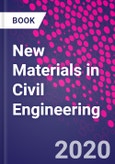New Materials in Civil Engineering provides engineers and scientists with the tools and methods needed to meet the challenge of designing and constructing more resilient and sustainable infrastructures. This book is a valuable guide to the properties, selection criteria, products, applications, lifecycle and recyclability of advanced materials. It presents an A-to-Z approach to all types of materials, highlighting their key performance properties, principal characteristics and applications. Traditional materials covered include concrete, soil, steel, timber, fly ash, geosynthetic, fiber-reinforced concrete, smart materials, carbon fiber and reinforced polymers. In addition, the book covers nanotechnology and biotechnology in the development of new materials.
Please Note: This is an On Demand product, delivery may take up to 11 working days after payment has been received.
Table of Contents
1. An overview of cementitious construction materials 2. Computational intelligence for modeling of pavement surface characteristics 3. Computational intelligence for modeling of asphalt pavement surface distress 4. Expanded polystyrene geofoam 5. Recycling of industrial wastes for value-added applications in clay-based ceramic products: a global review (2015-19) 6. Emerging advancement of fiber-reinforced polymer composites in structural applications 7. Fiber-reinforced concrete and ultrahigh-performance fiber-reinforced concrete materials 8. The superplasticizer effect on the rheological and mechanical properties of self-compacting concrete 9. Trends and perspectives in the use of timber and derived products in building facades 10. Dynamic response of laminated composite plates fitted with piezoelectric actuators 11. Functional nanomaterials and their applications toward smart and green buildings 12. Production of sustainable concrete composites comprising waste metalized plastic fibers and palm oil fuel ash 13. Alkali-activated concrete systems: a state of art 14. Porous concrete pavement containing nanosilica from black rice husk ash 15. Porous alkali-activated materials 16. Lightweight cement-based materials 17. Development of alkali-activated binders from sodium silicate powder produced from industrial wastes 18. Innovative cement-based materials for environmental protection and restoration 19. Comparative effects of using recycled CFRP and GFRP fibers on fresh- and hardened-state properties of self-compacting concretes: a review 20. Corrosion inhibitors for increasing the service life of structures 21. Use of fly ash for the development of sustainable construction materials 22. An innovative and smart road construction material: thermochromic asphalt binders 23. Resin and steel-reinforced resin used as injection materials in bolted connections 24. Swelling behavior of expansive soils stabilized with expanded polystyrene geofoam inclusion 25. New generation of cement-based composites for civil engineering 26. Potential use of recycled aggregate as a self-healing concrete carrier 27. Self-healing concrete 28. Equations for prediction of rubberized concrete compressive strength: a literature review 29. Influence of cobinders on durability and mechanical properties of alkali-activated magnesium aluminosilicate binders from soapstone 30. Fly ash utilization in concrete tiles and paver blocks 31. Problems in short-fiber composites and analysis of chopped fiber-reinforced materials
Authors
Pijush Samui Associate Professor, Dept. of Civil Engineering, National Institute of Technology Patna, Patna, Bihar, India.Dr. Samui is an Associate Professor in the Department of Civil Engineering at NIT Patna, India. He received his PhD in Geotechnical Engineering from the Indian Institute of Science Bangalore, India, in 2008. His research interests include geohazard, earthquake engineering, concrete technology, pile foundation and slope stability, and application of AI for solving different problems in civil engineering. Dr. Samui is a repeat Elsevier editor but also a prolific contributor to journal papers, book chapters, and peer-reviewed conference proceedings.
Dookie Kim Professor, Department of Civil and Environmental Engineering, Kongju National University, Republic of Korea. Dookie Kim is a Professor in the Department of Civil and Environmental Engineering, Kongju National University ,1223-24 Cheonan-daero, 31080, Republic of Korea. Professor Kim has a broad experience in structural dynamics. He published journal articles, conference papers, book chapters and 2 books. Nagesh R. Iyer Fellow of the Indian National Academy of Engineering and currently Dean (Infrastructure, Planning & Support) & Visiting Professor, Indian Institute of Technology Dharwad, India. Dr. Nagesh R. Iyer is a Fellow of the Indian National Academy of Engineering and is currently Dean of (Infrastructure, Planning and Support) and Visiting Professor, at the Indian Institute of Technology Dharwad. He was formerly Director of CSIR-Structural Engineering Research Centre and Coordinating Director of CSIR Madras Complex. Concurrently he held the posts of Acting Director and Distinguished Emeritus Professor at the Academy of Scientific and Innovative Research (AcSIR). He has over 44 years of experience in the computer-aided analysis and design of complex and large structures which include infrastructural facilities. Sandeep Chaudhary Professor, Discipline of Civil Engineering, Indian Institute of Technology Indore, Simrol, India. Prof. Sandeep Chaudhary is currently working as Professor in the Discipline of Civil Engineering, Indian Institute of Technology Indore, India. Before joining IIT Indore, he served as a faculty member in different capacities at MNIT Jaipur, India, for more than twenty years. His research group carries out both analytical and experimental studies, which range from microstructure studies to full-scale. He has Chaired "Technical Committee 1: Design� of the Asian Concrete Federation for three years and is presently heading "Standing Committee 1 (SC1): Design� of the Asian Concrete Federation.







